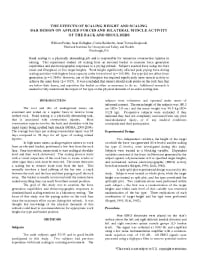Mining Publication: The Effects of Scaling Height and Scaling Bar Design on Applied Forces and Bilateral Muscle Activity of the Back and Shoulders
Original creation date: October 2006
Authors: WL Porter, S Gallagher, C Reinholtz, J Torma-Krajewski
NIOSHTIC2 Number: 20031497
Human Factors and Ergonomics Society 50th Annual Meeting, San Francisco, CA, Oct. 16-20, 2006; :1397-1400
Hand scaling is a physically demanding job and is responsible for numerous overexertion injuries in mining. This experiment studied rib scaling from an elevated bucket to examine force generation capabilities and electromyographic responses to a prying subtask. Subjects exerted force using two bars (steel and fiberglass) at five target heights. Work height significantly affected peak prying force during scaling activities with highest force capacity at the lowest level (p = 0.0188). Bar type did not affect force generation (p = 0.7843): However, use of the fiberglass bar required significantly more muscle activity to achieve the same force (p < 0.05). It was concluded that miners should scale points on the rock face that are below their knees, and reposition the bucket as often as necessary to do so. Additional research is needed to fully understand the impact of bar type on the physical demands of an entire scaling task.

NIOSHTIC2 Number: 20031497
Human Factors and Ergonomics Society 50th Annual Meeting, San Francisco, CA, Oct. 16-20, 2006; :1397-1400